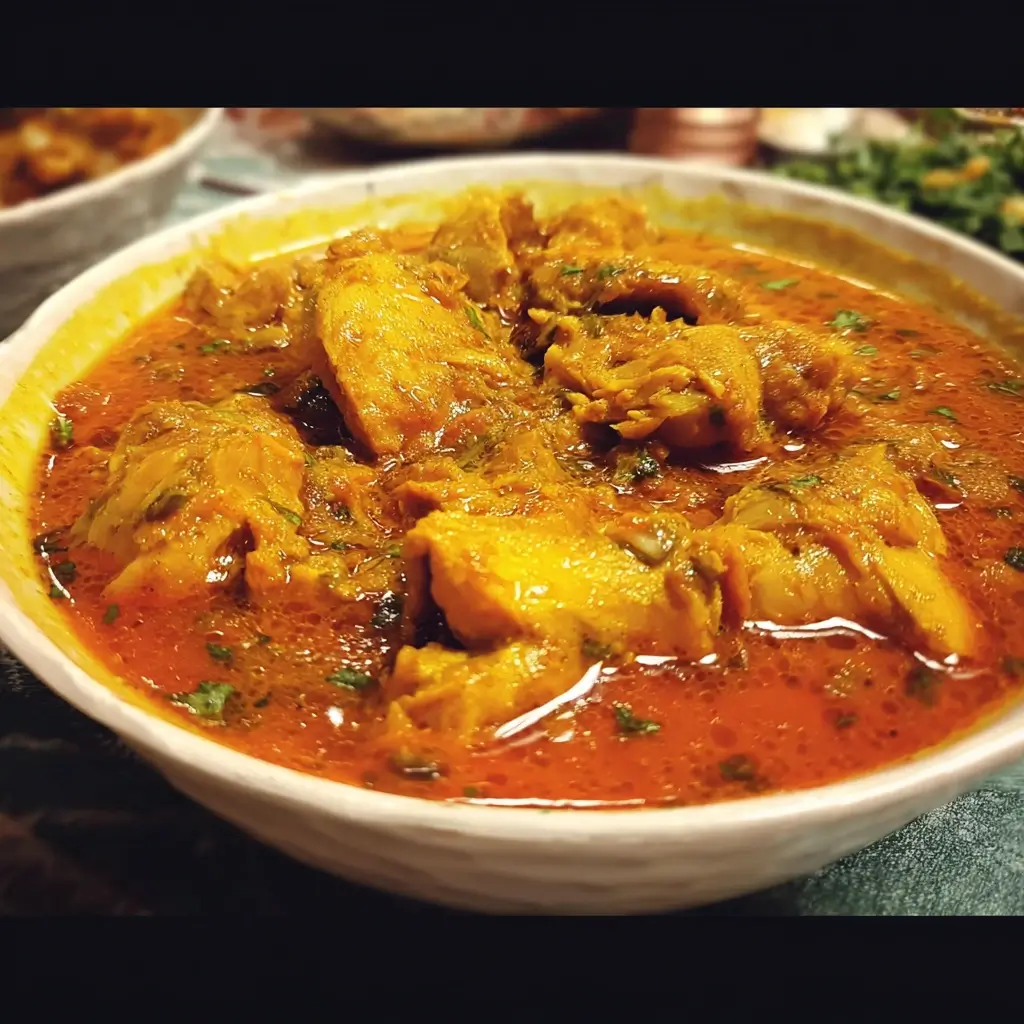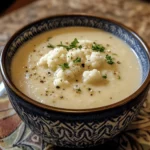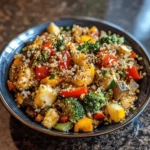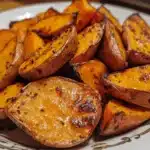Of all the dishes that have graced my family’s dinner table, none evoke the same level of comfort, nostalgia, and pure, unadulterated joy as a classic Indian Chicken Curry. I still remember the first time I attempted to recreate the magic from my mother’s kitchen. The air, thick with the earthy aroma of cumin and coriander, the sizzle of onions turning golden in the pan, the vibrant, fiery red of the chili powder blooming in the hot oil—it was a symphony of the senses. That evening, as my family gathered around the table, the silence was broken only by the clinking of spoons against plates and appreciative murmurs. My husband, usually a man of few words about food, looked up and said, “This tastes like home.” That was it. That was the ultimate seal of approval. This recipe isn’t just a set of instructions; it’s a legacy. It’s the result of years of tweaking, tasting, and perfecting a dish that is both profoundly simple and complex. It’s the go-to meal for chilly evenings, celebratory dinners, and days when only a bowl of hearty, flavorful curry will do. The secret, I’ve learned, lies not in a long list of exotic ingredients, but in the technique—the patient browning of the onions, the careful blooming of the spices, and the slow simmer that allows the chicken to become impossibly tender while soaking up every ounce of flavor from the rich, luscious gravy. This is more than just a recipe; it’s an invitation to create your own memories, to fill your home with the intoxicating fragrance of India, and to put a dish on the table that will have everyone asking for seconds.
The Ultimate Authentic Indian Chicken Curry Recipe
This recipe yields a homestyle North Indian chicken curry, often called ‘murgh curry’ or ‘chicken masala’. It balances heat, tang, and savory depth, resulting in a versatile dish that is a certified crowd-pleaser. The key is in using bone-in chicken for maximum flavor and taking the time to cook the onion and tomato base properly.
Ingredients
Here is the complete list of ingredients you’ll need. We’ve broken them down into three parts: for the chicken marination, for the whole spices, and for the curry base (masala).
For the Chicken Marinade:
- Chicken: 2.2 lbs (1 kg) bone-in, skinless chicken pieces (a mix of thighs and drumsticks is ideal), cut into medium-sized pieces
- Yogurt: ½ cup plain, full-fat yogurt (Greek or regular)
- Turmeric Powder: 1 teaspoon
- Red Chili Powder: 1 teaspoon (adjust to your heat preference, Kashmiri chili powder gives great color with less heat)
- Salt: 1 teaspoon
- Lemon Juice: 1 tablespoon, freshly squeezed
For the Whole Spices (Tadka):
- Oil: 4 tablespoons neutral oil (like canola, vegetable, or sunflower) or ghee for a richer flavor
- Cumin Seeds: 1 teaspoon
- Cinnamon Stick: 1-inch piece
- Green Cardamom Pods: 3-4 pods, lightly crushed
- Cloves: 4-5
- Black Peppercorns: 5-6
- Bay Leaf: 1 large
For the Curry Base (Masala):
- Onions: 2 large (about 3 cups), finely chopped or pureed
- Ginger-Garlic Paste: 2 tablespoons (ideally freshly made by blending equal parts ginger and garlic)
- Tomatoes: 3 medium (about 2 cups), pureed, or 1 (14.5 oz) can of crushed tomatoes
- Green Chilies: 2-3, slit lengthwise (optional, for extra heat and flavor)
- Coriander Powder: 2 tablespoons
- Cumin Powder: 1 tablespoon
- Red Chili Powder: 1-2 teaspoons (adjust to taste)
- Turmeric Powder: ½ teaspoon
- Garam Masala Powder: 1½ teaspoons (to be added at the end)
- Hot Water: 1 to 1½ cups, as needed for gravy consistency
- Salt: To taste (remember you’ve already added some to the marinade)
- Fresh Cilantro (Coriander Leaves): ½ cup, finely chopped, for garnish
- Kasuri Methi (Dried Fenugreek Leaves): 1 tablespoon (optional, but highly recommended for an authentic aroma)
Step-by-Step Instructions for Perfect Chicken Curry
Follow these detailed instructions carefully. Indian cooking is about layering flavors, so patience at each stage will reward you with an incredible final dish.
Step 1: Marinate the Chicken
In a large mixing bowl, combine the chicken pieces with all the ingredients listed under “For the Chicken Marinade”: yogurt, 1 teaspoon of turmeric powder, 1 teaspoon of red chili powder, 1 teaspoon of salt, and fresh lemon juice. Use your hands to thoroughly coat each piece of chicken with the marinade. Cover the bowl and let it rest for at least 30 minutes at room temperature, or for best results, refrigerate for 2 to 4 hours. This step is crucial as the yogurt and lemon juice tenderize the meat, while the spices begin to infuse it with flavor.
Step 2: Prepare the “Tadka” (Tempering the Spices)
Place a heavy-bottomed pot or Dutch oven over medium-high heat. Add the oil or ghee. Once the oil is hot (you’ll see it shimmer slightly), add all the whole spices: cumin seeds, cinnamon stick, green cardamom pods, cloves, black peppercorns, and the bay leaf. Let them sizzle for about 30-45 seconds until they become fragrant. This process, called “tadka” or “tempering,” blooms the spices and infuses the oil with their essential flavors. Be careful not to burn them.
Step 3: The “Bhunao” – Sautéing the Onions
Add the finely chopped or pureed onions to the pot. Sauté them on medium heat, stirring frequently. This is the most important and time-consuming step for building the curry’s flavor foundation. You need to cook the onions until they are deeply golden brown and have significantly reduced in volume. This can take anywhere from 12 to 18 minutes. Do not rush this process. Properly caramelized onions provide a subtle sweetness and deep, savory base that cannot be replicated. If they start to stick, add a splash of water and scrape the bottom of the pan.
Step 4: Cooking the Ginger, Garlic, and Tomatoes
Once the onions are perfectly browned, add the ginger-garlic paste and the slit green chilies (if using). Sauté for another 1-2 minutes until the raw smell of the ginger and garlic disappears. The kitchen will fill with an incredible aroma at this stage. Now, add the pureed tomatoes.
Step 5: Cooking the Masala Base
Stir the tomato puree into the onion mixture. Add all the powdered spices for the curry base: coriander powder, cumin powder, red chili powder, and ½ teaspoon of turmeric powder. Also, add salt to taste, starting with about ½ teaspoon. Mix everything thoroughly. Cook this masala mixture, stirring occasionally, for about 10-15 minutes. The goal is to cook until the paste darkens in color, thickens considerably, and you see the oil separating from the edges of the masala. This separation is the visual cue that your masala is perfectly cooked.
Step 6: Adding and Searing the Chicken
Add the marinated chicken pieces to the pot. Turn the heat up to high and sauté the chicken for 5-7 minutes, stirring gently to coat it completely with the masala. You want to sear the chicken on all sides. This locks in the juices and incorporates the flavors from the marinade into the curry base.
Step 7: Simmering the Curry
Once the chicken has a light brown sear, reduce the heat to medium-low. Add 1 to 1½ cups of hot water. The amount of water determines the thickness of your gravy; start with 1 cup for a thicker curry and add more if you prefer a thinner consistency. Stir everything well, scraping any bits from the bottom of the pot. Bring the curry to a gentle boil.
Step 8: The Final Cook
Cover the pot with a tight-fitting lid and let the curry simmer on low heat for 20-25 minutes, or until the chicken is cooked through and tender. The meat should easily pull away from the bone. The gravy will have thickened, and a layer of flavorful oil may float to the top, which is a sign of a well-cooked curry.
Step 9: Finishing Touches
Turn off the heat. Now, stir in the 1½ teaspoons of garam masala powder. This is added at the end to preserve its fragrant aroma. If you are using Kasuri Methi (dried fenugreek leaves), crush them between your palms to release their flavor and sprinkle them into the curry. Stir gently. Finally, garnish generously with freshly chopped cilantro. Let the curry rest for at least 10 minutes before serving to allow the flavors to meld together perfectly.
Nutrition Facts
- Servings: 6-8
- Calories per serving: Approximately 350-450 kcal (This is an estimate and can vary based on the specific cut of chicken, amount of oil used, and serving size.)
Preparation Time
- Marination Time: 30 minutes to 4 hours
- Active Preparation Time: 20 minutes
- Cooking Time: 55-65 minutes
- Total Time (excluding marination): Approximately 1 hour 20 minutes
How to Serve Indian Chicken Curry
Serving this curry with the right accompaniments elevates it from a simple meal to a fantastic feast. Here’s how to create the perfect Indian dining experience at home:
- With Indian Breads: This is the most classic way to enjoy chicken curry. The breads are perfect for scooping up the chicken and soaking up every last drop of the delicious gravy.
- Naan Bread: Soft, pillowy, and slightly chewy. Plain, butter, or garlic naan are all excellent choices.
- Roti or Chapati: A simpler, unleavened whole wheat flatbread that’s a staple in North Indian homes. It’s lighter than naan and perfect for everyday meals.
- Paratha: A flaky, layered flatbread, often cooked with ghee or oil. Laccha Paratha (layered paratha) is particularly good with rich curries.
- With Rice: A bed of fluffy, fragrant rice is another perfect partner for chicken curry.
- Steamed Basmati Rice: Long-grain Basmati rice is the gold standard. Its distinct aroma and fluffy texture complement the curry without overpowering it.
- Jeera Rice (Cumin Rice): Basmati rice tempered with cumin seeds, whole spices, and ghee. This adds another layer of flavor that works beautifully with the curry.
- Pea Pulao (Matar Pulao): A simple rice pilaf cooked with green peas and mild spices.
- With Side Dishes (Accompaniments): A few simple side dishes can balance the richness and spice of the curry.
- Raita: A cooling yogurt-based side dish. A simple cucumber and mint raita or a boondi raita (with tiny fried chickpea flour balls) is perfect to soothe the palate.
- Kachumber Salad: A simple and refreshing Indian salad made with finely chopped onion, tomato, cucumber, and cilantro, dressed with lemon juice and a pinch of salt and pepper.
- Pickled Onions (Sirke wale Pyaaz): Sliced onions soaked in vinegar with a bit of salt and sugar. Their sharp tang cuts through the richness of the curry beautifully.
- Papadum: Thin, crispy lentil wafers that can be roasted or fried, adding a delightful crunch to the meal.
Additional Tips for the Best Chicken Curry
- Marination is Not Optional: Don’t skip the marination step. The combination of yogurt and acid (lemon juice) is a classic tenderizing technique in Indian cooking. It breaks down the tough proteins in the chicken, ensuring it becomes succulent and melts in your mouth. Furthermore, it allows the initial layer of spices to penetrate deep into the meat, flavoring it from the inside out.
- The Magic is in the “Bhunao”: As mentioned in the instructions, the slow browning of the onions (bhunao) is the soul of this curry. Rushing this step will result in a curry that lacks depth and has a raw, oniony taste. Be patient, stir continuously, and cook them until they are a deep, uniform golden brown. This caramelization process releases sugars and creates complex, savory notes that form the backbone of the gravy.
- Use Fresh Ginger-Garlic Paste: While store-bought paste is convenient, the flavor of freshly made ginger-garlic paste is vastly superior. It has a pungent, bright flavor that pre-packaged versions lose over time. Simply peel equal amounts of fresh ginger and garlic cloves and blend them in a small food processor with a tiny splash of water to form a smooth paste. You can make a batch and store it in the fridge for up to a week.
- Control the Consistency and Heat: The consistency of the gravy is a personal preference. If your curry is too thick, simply add a bit more hot water until it reaches your desired consistency. If it’s too thin, let it simmer with the lid off for a few extra minutes to allow the excess water to evaporate. To control the spice level, use a mild chili powder like Kashmiri red chili powder for vibrant color without intense heat, and adjust the number of green chilies you add.
- Let it Rest for Better Flavor: Like many stews and braises, this Indian chicken curry tastes even better the next day. The resting period allows the spices to meld and mature, and the flavors to deepen significantly. If you have the time, make it a day in advance. When reheating, do so gently on the stovetop, adding a splash of water if needed to loosen the gravy.
Frequently Asked Questions (FAQ)
1. Can I use boneless chicken breast instead of bone-in chicken thighs?
Yes, you certainly can. However, there are a few things to keep in mind. Chicken breast is much leaner and can dry out if overcooked. To prevent this, cut the breast into larger, 1.5-inch chunks. Reduce the final simmering time from 20-25 minutes to about 10-15 minutes, or just until the chicken is cooked through. Bone-in, dark meat like thighs and drumsticks adds more flavor and richness to the gravy and remains more tender during the long simmer, which is why it’s traditionally preferred.
2. How can I make this curry creamier and less spicy for kids?
To make the curry creamier and richer, you can stir in 2-3 tablespoons of heavy cream or a couple of tablespoons of ground cashew paste (made by blending soaked cashews with a little water) during the last 5 minutes of cooking. To reduce the spice level, completely omit the green chilies and use a mild chili powder like paprika or Kashmiri chili powder. You can also increase the amount of yogurt in the marinade, which adds a cooling effect.
3. Is this Indian Chicken Curry freezer-friendly?
Absolutely! This curry freezes exceptionally well, making it a perfect dish for meal prepping. Let the curry cool down completely to room temperature. Transfer it to freezer-safe airtight containers or zip-top bags. It can be stored in the freezer for up to 3 months. To serve, thaw it overnight in the refrigerator and then reheat gently on the stovetop. You may need to add a splash of water or broth to adjust the consistency. Avoid adding fresh cilantro before freezing; add it after reheating for the best flavor.
4. I don’t have all the whole spices. Can I still make this?
Yes, you can. While the whole spices add a wonderful layer of aromatic complexity, the curry will still be delicious without them. The most crucial spices are the ground ones (coriander, cumin, turmeric) and the garam masala. If you have to skip some whole spices, the most important one to keep is cumin seeds for the initial “tadka”. If you don’t have any whole spices, you can simply heat the oil and proceed directly to sautéing the onions, perhaps adding an extra ½ teaspoon of ground cumin and a pinch of ground cinnamon with the other powdered spices.
5. My curry tastes a bit bland or bitter. What went wrong and how can I fix it?
There could be a few reasons.
- Blandness: This is often due to under-seasoning with salt or not cooking the onion-tomato masala long enough (the “bhunao” step). To fix it, first check the salt and add more if needed. You can also add a squeeze of lemon juice or a pinch of sugar to brighten and balance the flavors. A little extra garam masala at the end can also lift the taste.
- Bitterness: This is usually caused by burning the spices, ginger-garlic paste, or onions. Cooking the spices on too high a heat or for too long can make them bitter. Turmeric powder, if used in excess or not cooked properly, can also impart a slightly bitter, metallic taste. Unfortunately, it’s hard to completely remove a burnt taste. However, you can try to salvage it by adding a balancing agent like a tablespoon of cream, a teaspoon of sugar, or a few potato chunks (which can absorb some of the bitterness) and simmering for a little longer.
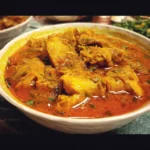
Authentic Indian Chicken Curry Recipe
Ingredients
For the Chicken Marinade:
- Chicken: 2.2 lbs (1 kg) bone-in, skinless chicken pieces (a mix of thighs and drumsticks is ideal), cut into medium-sized pieces
- Yogurt: ½ cup plain, full-fat yogurt (Greek or regular)
- Turmeric Powder: 1 teaspoon
- Red Chili Powder: 1 teaspoon (adjust to your heat preference, Kashmiri chili powder gives great color with less heat)
- Salt: 1 teaspoon
- Lemon Juice: 1 tablespoon, freshly squeezed
For the Whole Spices (Tadka):
- Oil: 4 tablespoons neutral oil (like canola, vegetable, or sunflower) or ghee for a richer flavor
- Cumin Seeds: 1 teaspoon
- Cinnamon Stick: 1-inch piece
- Green Cardamom Pods: 3-4 pods, lightly crushed
- Cloves: 4-5
- Black Peppercorns: 5-6
- Bay Leaf: 1 large
For the Curry Base (Masala):
- Onions: 2 large (about 3 cups), finely chopped or pureed
- Ginger-Garlic Paste: 2 tablespoons (ideally freshly made by blending equal parts ginger and garlic)
- Tomatoes: 3 medium (about 2 cups), pureed, or 1 (14.5 oz) can of crushed tomatoes
- Green Chilies: 2-3, slit lengthwise (optional, for extra heat and flavor)
- Coriander Powder: 2 tablespoons
- Cumin Powder: 1 tablespoon
- Red Chili Powder: 1-2 teaspoons (adjust to taste)
- Turmeric Powder: ½ teaspoon
- Garam Masala Powder: 1½ teaspoons (to be added at the end)
- Hot Water: 1 to 1½ cups, as needed for gravy consistency
- Salt: To taste (remember you’ve already added some to the marinade)
- Fresh Cilantro (Coriander Leaves): ½ cup, finely chopped, for garnish
- Kasuri Methi (Dried Fenugreek Leaves): 1 tablespoon (optional, but highly recommended for an authentic aroma)
Instructions
In a large mixing bowl, combine the chicken pieces with all the ingredients listed under “For the Chicken Marinade”: yogurt, 1 teaspoon of turmeric powder, 1 teaspoon of red chili powder, 1 teaspoon of salt, and fresh lemon juice. Use your hands to thoroughly coat each piece of chicken with the marinade. Cover the bowl and let it rest for at least 30 minutes at room temperature, or for best results, refrigerate for 2 to 4 hours. This step is crucial as the yogurt and lemon juice tenderize the meat, while the spices begin to infuse it with flavor.
Place a heavy-bottomed pot or Dutch oven over medium-high heat. Add the oil or ghee. Once the oil is hot (you’ll see it shimmer slightly), add all the whole spices: cumin seeds, cinnamon stick, green cardamom pods, cloves, black peppercorns, and the bay leaf. Let them sizzle for about 30-45 seconds until they become fragrant. This process, called “tadka” or “tempering,” blooms the spices and infuses the oil with their essential flavors. Be careful not to burn them.
Add the finely chopped or pureed onions to the pot. Sauté them on medium heat, stirring frequently. This is the most important and time-consuming step for building the curry’s flavor foundation. You need to cook the onions until they are deeply golden brown and have significantly reduced in volume. This can take anywhere from 12 to 18 minutes. Do not rush this process. Properly caramelized onions provide a subtle sweetness and deep, savory base that cannot be replicated. If they start to stick, add a splash of water and scrape the bottom of the pan.
Once the onions are perfectly browned, add the ginger-garlic paste and the slit green chilies (if using). Sauté for another 1-2 minutes until the raw smell of the ginger and garlic disappears. The kitchen will fill with an incredible aroma at this stage. Now, add the pureed tomatoes.
Stir the tomato puree into the onion mixture. Add all the powdered spices for the curry base: coriander powder, cumin powder, red chili powder, and ½ teaspoon of turmeric powder. Also, add salt to taste, starting with about ½ teaspoon. Mix everything thoroughly. Cook this masala mixture, stirring occasionally, for about 10-15 minutes. The goal is to cook until the paste darkens in color, thickens considerably, and you see the oil separating from the edges of the masala. This separation is the visual cue that your masala is perfectly cooked.
Add the marinated chicken pieces to the pot. Turn the heat up to high and sauté the chicken for 5-7 minutes, stirring gently to coat it completely with the masala. You want to sear the chicken on all sides. This locks in the juices and incorporates the flavors from the marinade into the curry base.
Once the chicken has a light brown sear, reduce the heat to medium-low. Add 1 to 1½ cups of hot water. The amount of water determines the thickness of your gravy; start with 1 cup for a thicker curry and add more if you prefer a thinner consistency. Stir everything well, scraping any bits from the bottom of the pot. Bring the curry to a gentle boil.
Cover the pot with a tight-fitting lid and let the curry simmer on low heat for 20-25 minutes, or until the chicken is cooked through and tender. The meat should easily pull away from the bone. The gravy will have thickened, and a layer of flavorful oil may float to the top, which is a sign of a well-cooked curry.
Turn off the heat. Now, stir in the 1½ teaspoons of garam masala powder. This is added at the end to preserve its fragrant aroma. If you are using Kasuri Methi (dried fenugreek leaves), crush them between your palms to release their flavor and sprinkle them into the curry. Stir gently. Finally, garnish generously with freshly chopped cilantro. Let the curry rest for at least 10 minutes before serving to allow the flavors to meld together perfectly.
Nutrition
- Serving Size: One Normal Portion
- Calories: 350-450


